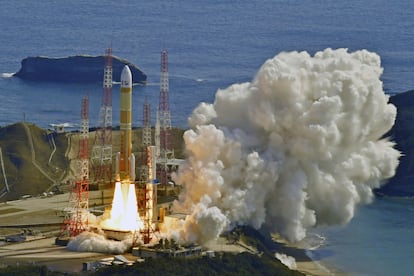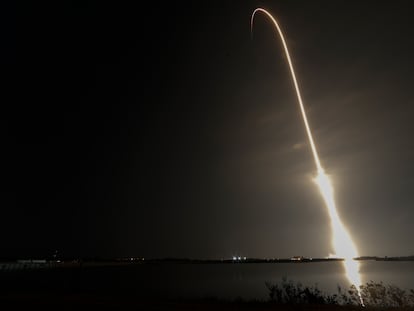Japan launches H3 rocket, destroys it over 2nd-stage failure
The H3′s failure was a setback for Japan’s space program and a disappointment for space fans who were rooting for Tuesday’s retrial.

Japan’s space agency intentionally destroyed a new H3 rocket minutes after its launch Tuesday because the ignition failed for the second stage of the country’s first new rocket series in more than two decades. Coming three weeks after an aborted launch due to a separate glitch, the H3′s failure was a setback for Japan’s space program — and possibly for its missile detection program — and a disappointment for space fans who were rooting for Tuesday’s retrial.
The H3 rocket with a white head blasted off and soared into the blue sky from the Tanegashima Space Center in southern Japan as fans and local residents cheered. It followed its planned trajectory and the second stage separated as designed, but the ignition for it failed, the Japan Aerospace Exploration Agency said.
JAXA officials apologized for the failure, and said it sent a command to destroy the rocket about 14 minutes after liftoff as there was no hope for it to complete its mission.
Yasuhiro Funo, JAXA director for launch implementation, said the second stage and its payload fell into the deep sea off the eastern coast of the Philippines. He said the rocket, which was not going to enter the targeted orbit while carrying a lot of fuel, was unsafe and had to be destroyed.
No damages or injuries were reported from the destruction of the rocket or its falling debris.
The rocket was carrying an Advanced Land Observation Satellite, or ALOS-3, tasked primarily with Earth observation and data collection for disaster response and mapmaking, and an experimental infrared sensor developed by the Defense Ministry that can monitor military activity including missile launches.
There is no plan for an alternative satellite launch to replace the earlier generation of ALOS, said Katsuhiko Hara, Education, Culture, Sports, Science and Technology minister. He did not say if or how the delay could affect disaster and missile detection capability.
The failure is the second in six months since a smaller Epsilon-series solid-fueled rocket designed to launch scientific satellites failed in October.
The H3 launch had also been held up more than two years because of an engine development delay. During a launch attempt in February, an electrical glitch after the main engine ignition aborted the launch just before its liftoff and narrowly saved the rocket.
Further delay is expected, but JAXA officials said analyzing the malfunction and rebuilding trust comes first.
“Our top priority is to do everything we can to find the cause and regain the trust in our rockets,” said JAXA President Hiroshi Yamakawa at a joint news conference. “We need to figure out what we should do to successfully achieve the next launch.”
Yamakawa said global competitiveness is still important. “Delays and additional costs are both burdens, but we will achieve international overall competitiveness from the perspectives of cost and user friendliness in delivering satellites.”
The H3 rocket — Japan’s first new series in more than 22 years — was developed at a cost of 200 billion yen ($1.47 billion) by JAXA and Mitsubishi Heavy Industries as a successor to Japan’s H-2A rocket, which is due to retire after its upcoming 50th launch.
The H3, about 60 meters (196 feet) long, can carry larger payloads than the 53-meter (174-foot) H-2A. But its launch cost has been slashed approximately in half to about 50 million yen ($368,000) by simplifying its design, manufacturing and operation in an effort to win more commercial launch customers. The hydrogen-fueled main engine is newly developed and uses fewer parts by altering the combustion method.
The space launch business has become increasing competitive, with major players including SpaceX and Arianespace.
Sign up for our weekly newsletter to get more English-language news coverage from EL PAÍS USA Edition
Tu suscripción se está usando en otro dispositivo
¿Quieres añadir otro usuario a tu suscripción?
Si continúas leyendo en este dispositivo, no se podrá leer en el otro.
FlechaTu suscripción se está usando en otro dispositivo y solo puedes acceder a EL PAÍS desde un dispositivo a la vez.
Si quieres compartir tu cuenta, cambia tu suscripción a la modalidad Premium, así podrás añadir otro usuario. Cada uno accederá con su propia cuenta de email, lo que os permitirá personalizar vuestra experiencia en EL PAÍS.
¿Tienes una suscripción de empresa? Accede aquí para contratar más cuentas.
En el caso de no saber quién está usando tu cuenta, te recomendamos cambiar tu contraseña aquí.
Si decides continuar compartiendo tu cuenta, este mensaje se mostrará en tu dispositivo y en el de la otra persona que está usando tu cuenta de forma indefinida, afectando a tu experiencia de lectura. Puedes consultar aquí los términos y condiciones de la suscripción digital.
More information

SpaceX launches US, Russia, UAE astronauts to space station

Last-minute problem keeps SpaceX rocket, astronauts grounded
Archived In
Últimas noticias
Nazareth Castellanos, neuroscientist: ‘We need to teach anxiety prevention techniques from school onwards’
Oona Chaplin: ‘I told James Cameron that I was living in a treehouse and starting a permaculture project with a friend’
Madrid, the second region in Europe with the most roundabouts thanks to urban speculation: One for every 30 intersections
Amy Taylor, singer of Amyl and the Sniffers: From selling nuts to opening for AC/DC
Most viewed
- Charles Dubouloz, mountaineering star, retires at 36 with a farewell tour inspired by Walter Bonatti
- CBS in crisis after pulling a report on Trump’s deportations to El Salvador (which later leaked online)
- December Social Security and SSI payments: Dates, double checks and the 2026 COLA increase
- Venezuela faces its most tense Christmas yet
- Bukele clan fumes over investigation exposing their new wealth








































